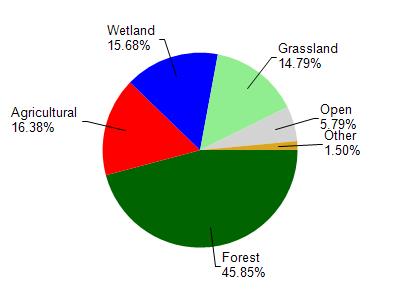Polk
No
No
Yes
Fish and Aquatic Life
Overview
This flow-through lake is located on the Straight River. A 1981 feasibility study documented a eutrophic body of water subjected to algae blooms and excessive vegetation growths. Recent contacts with this lake district have indicated a resurgent interest in lake management. This lake should be accorded a high priority for planning grants to help them in developing the long range management schemes to effectively utilize their lake within the limitations of the natural barriers present. A high priority should also be given to any funding for implementation practices which could reasonably achieve the alternatives suggested in the 1981 study.
Date 1992
Author Aquatic Biologist
Historical Description
Blake Lake is situated on the Straight River, a navigable stream (1.8 cfs). Lost Creek, a nonnavigable stream also flows into this lake. Fish present include walleyes, northern pike, largemouth bass, bluegills, black crappies, perch, pumpkinseed and bullheads. Sixty-five per cent of the shore line is privately developed with three resorts and forty-eight cottages. Public frontage on the take consists of one improved access road (50 feet) with limited parking.
Source: 1961, Surface Water Resources of Polk County Blake Lake T35N, R16W, Sec. 22, 26, 27 Surface Acres = 91. 5, S. D. F. = 2.85, Maximum Depth = 12 ft., M. P.A. = 108
Date 1961
Author Aquatic Biologist
Recommendations
Best Management Practices, Implement
Partnering with property owners, the applicant is sponsoring a grant to implement water quality and habitat best practices from Wisconsin's Healthy Lakes Implementation Plan. Best practices, including fish sticks, 350 sq. ft. native plantings, diversions, rock infiltration, and/or rain gardens, will be designed and installed according to the Healthy Lakes fact sheets, technical guidance and grant application.
Lakes Planning Grant
Lake Management Plan Development
Information and Education
Watershed Mapping or Assessment
Runoff Evaluation
Monitor Water Quality or Sediment
Informational Meetings
Aquatic Plant Management Plan
The Blake Lake Protection and Rehabilitation District will assess and characterize the current seasonal changes in the aquatic plant community structure, littoral aquatic macroinvertebrate community structure, and shoreline land use for Blake Lake in Polk County.
Management Goals
Wisconsin's Water Quality Standards provide qualitative and quantitative goals for waters that are protective of Fishable, Swimmable conditions [Learn more]. Waters that do not meet water quality standards are considered impaired and restoration actions are planned and carried out until the water is once again fishable and swimmable
Management goals can include creation or implementation of a Total Maximum Daily Load analysis, a Nine Key Element Plan, or other restoration work, education and outreach and more. If specific recommendations exist for this water, they will be displayed below online.
Monitoring
Monitoring the condition of a river, stream, or lake includes gathering physical, chemical, biological, and habitat data. Comprehensive studies often gather all these parameters in great detail, while lighter assessment events will involve sampling physical, chemical and biological data such as macroinvertebrates. Aquatic macroinvertebrates and fish communities integrate watershed or catchment condition, providing great insight into overall ecosystem health. Chemical and habitat parameters tell researchers more about human induced problems including contaminated runoff, point source dischargers, or habitat issues that foster or limit the potential of aquatic communities to thrive in a given area. Wisconsin's Water Monitoring Strategy was recenty updated.
Grants and Management Projects
Monitoring Projects
| WBIC | Official Waterbody Name | Station ID | Station Name | Earliest Fieldwork Date | Latest Fieldwork Date | View Station | View Data |
|---|
| 2627000 | Big Blake Lake | 493144 | Big Blake Lake - Deep Hole/Main Basin | 11/2/1990 | 9/8/2025 | Map | Data |
| 2627000 | Big Blake Lake | 10020933 | Big Blake Lake -- Access at W Side - Baker Road | 5/25/2007 | 9/15/2025 | Map | Data |
| 2627000 | Big Blake Lake | 10005007 | Big Blake Lake | 9/5/2000 | 8/20/2025 | Map | Data |
| 2627000 | Big Blake Lake | 10018332 | Big Blake Lake -- Access at North - End Of Bystrom Ln | 7/20/2002 | 8/15/2025 | Map | Data |
|

Watershed Characteristics
Big Blake Lake is located in the Upper Apple River watershed which is 195.43 mi². Land use in the watershed is primarily forest (45.90%), agricultural (16.40%) and a mix of wetland (15.70%) and other uses (22.10%). This watershed has 138.62 stream miles, 7,663.43 lake acres and 16,247.07 wetland acres.
Nonpoint Source Characteristics
This watershed is ranked Medium for runoff impacts on streams, High for runoff impacts on lakes and Low for runoff impacts on groundwater and therefore has an overall rank of Low. This value can be used in ranking the watershed or individual waterbodies for grant funding under state and county programs.This water is ranked High Lake for individual Lakes based on runoff problems and the likelihood of success from project implementation.